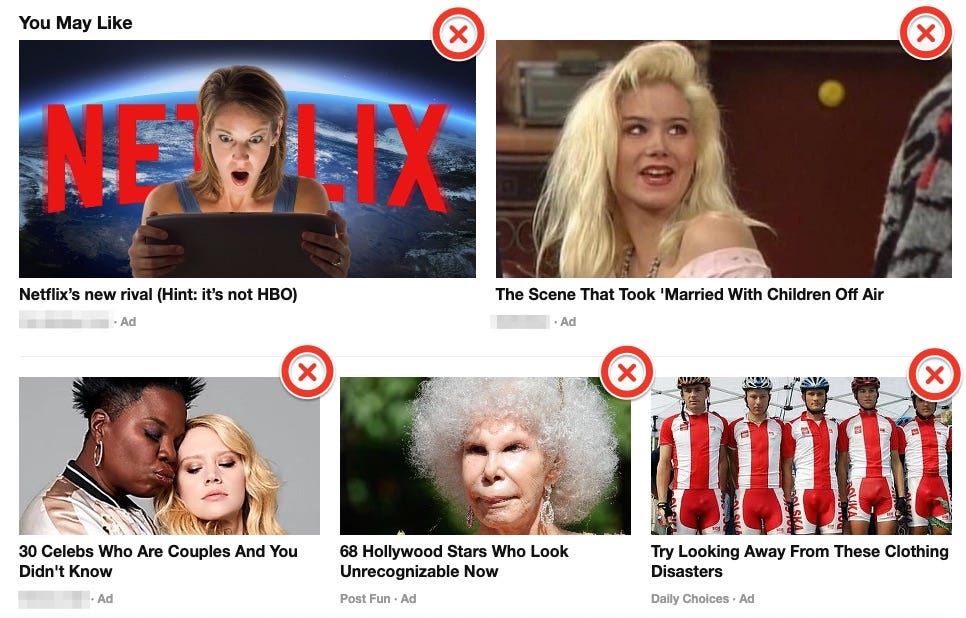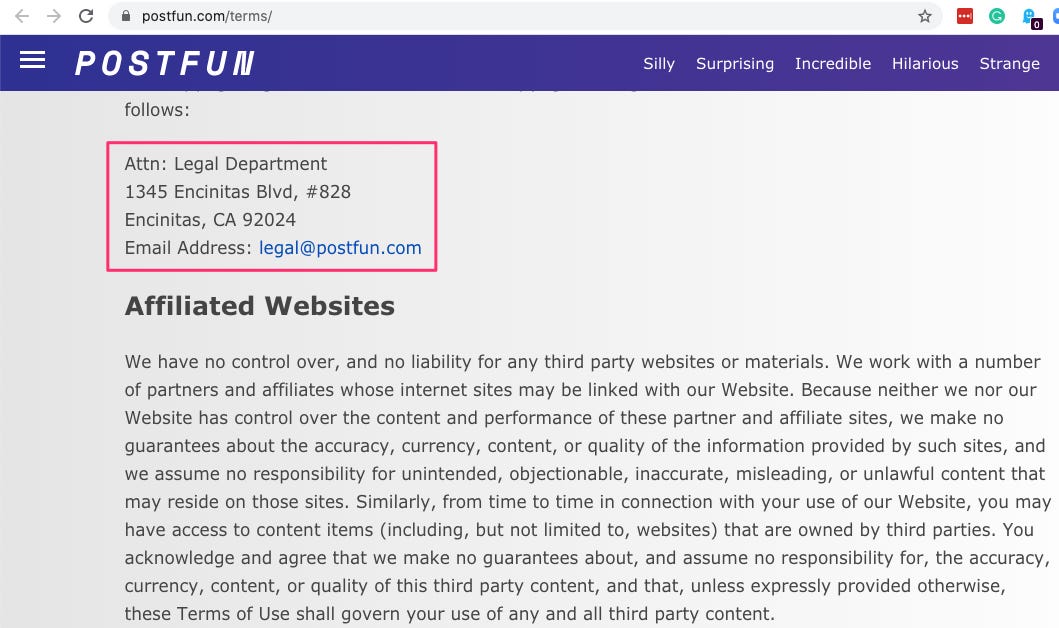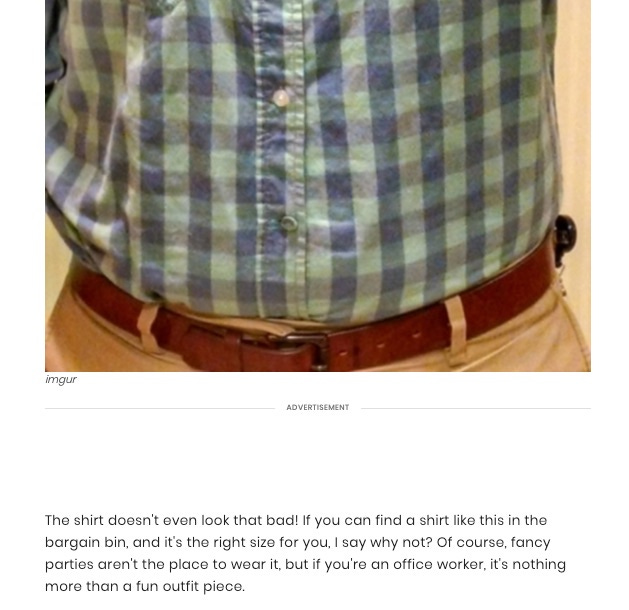
This is Clickbait
Marketers keep buying it even though the results are questionable.
Well, you clicked this story anyway. You blew it! (Just kidding)
This week's AdLingo covers the detrimental impact of Clickbait on performance media campaigns. This week, we get in the weeds a bit. Time to get nerdy.
Historians have proven that clickbait was the first invention built on top of the internet. (No, they did not.)
Ok, fine. However, clickbait has been around basically since the beginning. Even before the content monetization methods we know and love today existed, humans were addicted to internet metrics.
Stop and think about it, your brain literally gives you a shot of dopamine when your metrics tick up.
- Pageviews
- Uniques
- Likes
- Comments
- Retweets
- Shares
- Upvotes
- Reactions
- Interactions
- Followers
- Video views
- Podcast downloads
- Subscribes
There have been many studies about this, and there's a consensus among the researchers, including Harvard. Admittedly, I started AdLingo as a little creative brain dump back in 2018 and was thrilled when 4 people a week read it. Now that it has taken off, I find myself getting more and more addicted to the subscriber growth numbers.
What does this have to do with paid marketing?
As marketers, we are addicted to the fluff in our metrics and attribution models and not focused on the performance indicators that improve our businesses. There’s a carnial need for more reach, more clicks, and more views of our campaigns. We make the assumption that it translates directly to performance. In reality, that’s rarely the case, but the numbers still feel like they should be right.
Organic marketing specialists have been tapping into the clickbait game since day one, and now so are the traditional display and video performance marketers. I do not mean that in a disparaging way at all. It’s the earned media specialst’s job to get views and likes, and nothing does that better than FOMO inducing headline.
On the paid front, campaigns using post-impression attribution, post-click (to a lesser extent) are the problem. The formula [unintentionally?] overvalues clickbait fluff and ignores what really drives the business.
Key Term: Post-impression attribution. In its simplest form, this type of attribution awards credit for a conversion or sale to the most recent impression served within a certain lookback window.
Translation: If someone buys your stuff, or performs your desired action, and was served a paid online ad in the last ___ hours or days, the site that served that ad receives credit for having driven the outcome.
I've written pretty extensively about this issue over the years, but today we drill down on clickbait.
What's the impact?
Garbage clickbait content has one goal: generate ad impressions.
Plain old CPM based ad revenue derived from clickbait content is a profitable business for content farms. It preys on the uninformed small or medium-sized marketer that is unaware of their own victimization.
Then there are performance-based campaigns that fall victim to clickbait too. Affiliate marketers or anyone that pays based on a CPA are hot marks. The less obvious, but even more profitable, are CPA optimized campaigns paying based on a CPM.
What is this witchcraft?
Many (if not most) major brand campaigns that optimize based on a cost-per-acquisition are traded based on a CPM. In other words, the campaign activation team at your agency is responsible for hitting a target cost-per-action target but buys all of the media based on a CPM.
This leads to campaign optimization techniques that naturally favor HIGH post impression actions and LOW CPMs. (I know, that's obvious.)
Why is that potentially a bad thing? Because it favors the game instead of the desired business driver.
In the model described above, optimizations favor volume of unique impressions, even if those impressions are complete garbage. Even if those impressions are not ever viewed. Even if those impressions are only on screen for 0.5 seconds.
The bounce rates on clickbait articles are astronomical, but it doesn't matter. As long as some ads loaded and some cookies had an opportunity to set, that is all that matters.
Those impressions were relatively cheap compared to legitimate content. There are also tons of clickbait impressions available to buy compared to legitimate, quality content.
After the first week of a campaign, when the first significant wave of optimizations are made, more weight (share of spend) will flow to the sites maximizing unique cookie sets at low unit rates.
Long story short: Spend is optimized towards content that, in reality, had very little influence on driving the desired outcome (clickbait). Your campaign is optimized toward content with the appearance of driving performance when nothing could be further from the truth.
For example
Let’s take a look at this article from a well-known website as an example. At the bottom of the legitimate news article are some “You may also like…” tiles. Many folks in the business refer to these as native ads.

“Try Looking Away From These Clothing Disasters” links to a site that we all know and love, PostFun.com [sarcasm].
“68 Hollywood Starts Who Look Unrecognizable Now” links to the juggernaut site, Daily-Choices.com.
PostFun.com is a website where its Terms of Service and Privacy policy include a mailing address of:

Do you live in Encinitas, CA? Then you probably recognize PostFun.com, right? After all, that address is a rented mailbox inside of the Sprouts Farmer’s Market, operated by Postal Annex.
Then there’s Daily-Choices.com, owned by Samyo. From best I can tell, Samyo is based in Tel Aviv, and has approximately 5 employees. I’m not saying that is a bad thing at all, but simply that there should be certain expectations about the size and quality of a five-person shop.
In case you were wondering, once your visit the story about “…Clothing Disasters,” you are invited to click through a gallery of individual pages including ones like this:

Not for nothing, I’ve never felt more seen than that photo.
Are these legitimate content sites? I guess that is up to you as a marketer to answer. No judgment from me. Here’s a little test though. Ask the next 1,000 people you see if they have heard of either of these sites by name.
You may also like
The addiction to clickbait media metrics such as likes, views, and subscribes are akin to paid media metrics like unique reach, total audience, and impressions. In other words, how much “reach” did you really achieve 90% of your ads were never viewed longer than a second? Your models are probably telling you to optimize towards content that’s just really good at casting a wide cookie-setting net including customers that would have converted organically.
The cost of quality is not really as high as you may think. Once you do the math and remove the weighted credit awarded to clickbait content, you’re left with the media that had the best chance of making a real impact. As a matter of fact, it was probably the only media that has been driving real outcomes since day one.
This whole time, you’ve been paying for high-quality conversions at high-quality prices. It was just buried in clickbait soup intended to bring down the perceived CPA by taking credit for organic conversions.

- Do pull a list of the last 500 domains your campaign ran on. Sort the list by volume of impressions or media spend. Then start scrolling. After domain #57, you are probably well into sites you’ve never heard of. Pick one that looks odd to you and visit the site. Is it legit? Is it super clickbaity? Can you tell who owns the site? Is it scraped content?
- Do ask your attribution vendor or agency about weighting impressions. Find out what is possible. Can you weight the value of an impression based on the time a user was on the page?
- Do make sure you have documentation regarding your Top 100 media domains, and the techniques used to generate website traffic. The top 75-ish probably have mostly organic techniques. Beyond that, we start crossing into paid “You may also like…” stuff and paid search.
- Do understand that this is a lot of work, but costs less than wasting your money on ads that do not have an impact on your business.
- Do ask tough questions. If something sounds shady, ask. If you visit a website and can’t figure out who owns it, ask. If all the content is photo galleries and listicles, ask why that content allegedly performs. Ask. Ask. Ask.

🚀 5-seconds of Reddit winning the Super Bowl.
💵 Is it me, or is Terry closing a deal every other day? Parse.ly got bought by Wordpress and offers a Google Analytics alternative.
💰 SpotX sells to Magnite (f/k/a Rubicon) to create the mother of all video SSP’s. (Another Luma deal.)
🏈 Not a link, just a note to say I’m proud of you buddy. You made it past the Superbowl in a pandemic. Now it’s Tuesday, back to work. Your reports are already late.
📌 How long until Elon’s Starlink solves geo location for all of our campaigns? (Wishful thinking.) He’s literally spamming space with satellites as we speak.
🏠 AdLingo will be doing recon inside Clubhouse starting this week. More details to come.
Support Independence
Getting the FREE AdLingo newsletter supports independent commentary, education, and insight into digital advertising.







